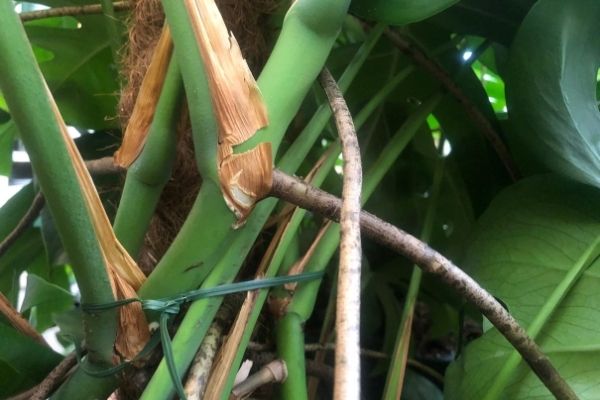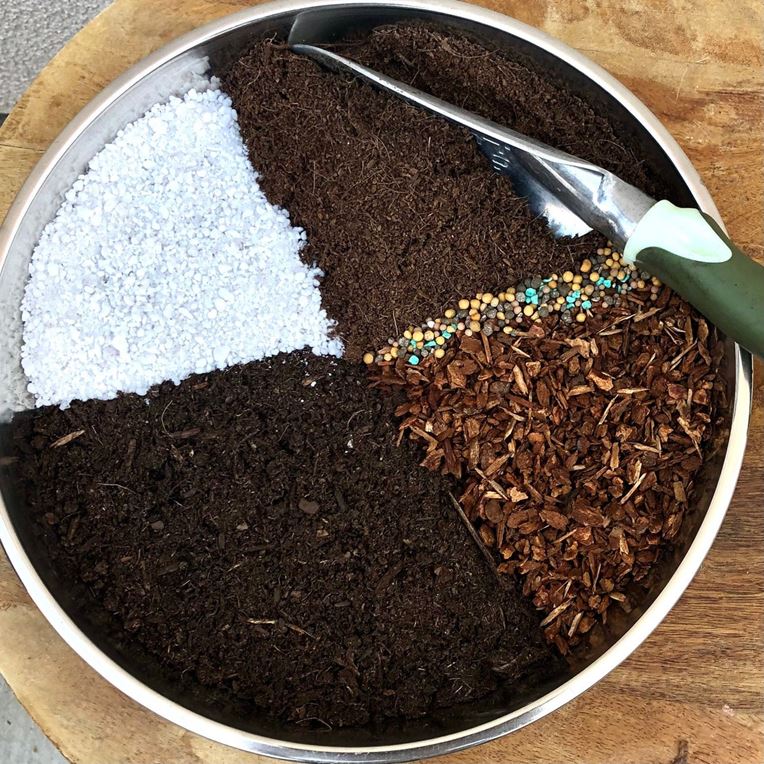
When the Monstera plant grows large enough and begins to lose stability and its stems begin to elongate, it will grow aerial roots. However, the aerial roots can start to rot if the plant is not cared for properly.
Monstera aerial root rot is quite common and can be treated in a number of ways.
Monstera aerial root rot can be recognized by a brown and mushy aerial root, foul odor, and/or slow growth. It is often caused by too damp conditions, rotting of the normal roots, or poorly functioning aerial roots. Treatment can be done by removing the rotting parts from the plant.
Whether you are dealing with a little bit of aerial root rot, or a big part of the plant is rotting, this article got you covered!
Contents
- Signs of aerial root rot in Monstera plant
- Brown and mushy aerial root
- Foul odor
- Slow growth
- What causes the aerial roots of the Monstera to rot
- Excess amount of water
- Underground roots are rotting
- Poorly functioning aerial roots
- How to treat Monstera aerial root rot
- Cut off the rotting aerial root
- How to prevent aerial root rot in monstera?
- Don't water too much!
- Keep humidity between 50% and 70%
- Use a well-draining soil mix
- Use a pot with drainage holes
Signs of aerial root rot in Monstera plant
As a multifunctional part of the plant, the aerial root is often an indicator of the general condition of the plant. Changes in its color, appearance, and structure suggest that some of the environmental factors have changed.
It's not always a bad thing if the appearance of the aerial roots change, this might be age-related.
However, when the Monstera aerial roots are rotting you might stumble upon different kinds of signs. Below are three signs of aerial root rot in Monstera plants.
Brown and mushy aerial root
If the aerial roots of the Monstera plant are rotting, they become brown and mushy.
Monstera is a plant that likes conditions of increased humidity in both soil and air. However, excessive amounts of moisture or insufficient and excessive spraying of the plant will lead to an imbalance and cause the aerial roots to rot.
The water drops that stay on the aerial root by spraying can cause them to change color and turn brown, mushy and begin to decay.
Foul odor
Root rot is a process that takes place in the pot in which the plant grows. When the plant begins to show signs of the disease in its aboveground part, it is usually a process that has already advanced and from which the plant can hardly recover.
One of the first signs that the rotting process has begun is an unpleasant decay odor that spreads from the pot or the entire plant. It is the consequence of excess water that the plant cannot take in.
Slow growth
In optimal conditions, the Monstera is a plant that grows quite quickly. It can reach a height of one to two feet during a season.
However, a plant that grows in unfavorable conditions will slow down the growth and give a few new leaves that will be much smaller and will not reach their full size.
The plant's slow growth can be caused by various factors, of which inadequate watering or insufficient lighting are the most common.
The same deformation occurs when the substrate in which the plant grows does not contain enough nutrients, or the roots are compacted in a pot, and there is not enough room to develop.
What causes the aerial roots of the Monstera to rot
Excess amount of water
Both overwatering and very high levels of humidity (above 70%) can cause excess water for the Monstera plant.
The excess water that the plant fails to absorb remains around its root. Combined with the high temperature that monstera prefers, it makes ideal conditions for various bacterial diseases development.
Bacteria are pathogenic microorganisms that destroy plant tissue, change functions, and weaken the plant. An infected plant slows its growth down, and if you don't take the proper steps, it can die away.
Underground roots are rotting
Rotting of the aerial roots of a plant can occur as a result of decaying that has started in the substrate, affected the underground rootball, and spread to other parts of the plant, including aerial roots.
The rotting of the underground roots is primarily caused by prolonged exposure to excess water which will cause poor aeration of the roots (leading to root rot).
Poorly functioning aerial roots
If the monstera grows in conditions with low humidity levels in the air, its aerial roots will develop poorly and will not have the ability to hold the plant attached to the substrate. Also, an insufficiently watered plant has the same problem. Its aerial roots atrophy rapidly and do not perform their function.
Also, if the Monstera is not taken care of correctly and is weak, the aerial roots are more likely to start rotting.
How to treat Monstera aerial root rot
To help a plant that has rotten aerial roots, you must first determine why this deformation occurred. First, make sure that the root ball in the pot is healthy. Carefully remove the soil around it. If you notice brown, brittle, and mushy parts of the roots, you must solve this problem first.
Here is how you can do it step by step:
- Carefully remove the plant from the pot and clean the root from the ground under running water. Use sharp scissors that you have previously sterilized with medical alcohol.
- Inspect the root and remove any parts that look sick, are brown and rotten. Dry it with kitchen paper.
- Leave the plant in a shaded place to dry in the air. Depending on the size of the remaining rootball, you can leave the plant for two or three hours. If the plant has a developed root, you can let it stay that way all day.
- When the root has dried, transplant the plant into a new fresh substrate. The best option is to use a new container. However, you can also sterilize the old one. Sterilization will make sure that pathogens have not remained on its walls.
In the rotten root treatment, as a disinfectant, you can use 3% hydrogen mixed with water in a ratio of 1:3. You can wash the root in this solution, or you can spray it on the rootball.
Cut off the rotting aerial root
If the plant roots have not been affected by rot but are whitish and healthy, then the decay of the aerial roots is due to the high humidity in the air. It usually occurs when you mist the plant too often. In this case, you can do the following:
Although the aerial roots are an integral part of the monster, it is still best to remove them as soon as they begin to rot. Remove them with a sharp, sterilized knife or scissors as close to the stem as possible. It will not harm the plant, and it will prevent the spread of rot to other parts of the plant.
How to prevent aerial root rot in monstera?
The best way to avoid these problems is prevention, as it is always better to prevent problems than to fix them. Moderate watering adapted to the plant's needs, an adequate substrate that does not retain water for long, and a container with a mandatory drainage hole will keep the problems away.
Don't water too much!
A proper watering regime is vital for healthy plant growth. Generally, water it once a week, allowing the surface layer of the substrate to dry out to a depth of 1-2 inches between waterings.
It is also essential to water the plant in the morning, reducing the risk of excess moisture accumulation since there is enough time during the day for the water to evaporate.
Keep humidity between 50% and 70%
High humidity in the air is also a prerequisite for successful monstera growth. However, you don't want to have too high humidity levels.
Keep the humidity in the range of 50 to 70%. Humidifiers or pebble trays are acceptable solutions, which raise the moisture level in a safer way than spraying.
Click here to purchase a good humidifier.
Use a well-draining soil mix
Hard-compacted and dense soils retain moisture for a long time and do not provide enough aeration for the roots, which increases the possibility of root rot.
Therefore, for your monstera, choose light, well-drained soil.
You can use a ready-made mixture for tropical plants, but you can also make a mixture of 1 part peat moss or coco coir, 1 part perlite, and 4 part pine bark fines.
Use a pot with drainage holes
Monstera is a plant that needs a pot with a drainage hole so that the excess water will not remain at the bottom of the vessel as this is a recipe for trouble.
Ideally, you want to have a pot with a saucer. When watering the Monstera, water thoroughly until you see water coming through the drainage holes.
Only water again when the top 1-2 inches of the soil are dry to the touch again.



